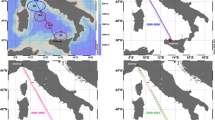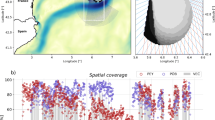Summary
A series of nine XBT sections is used to study the persistence in the general pattern of the North Atlantic Current. A large meander between the Newfoudland Continental Slope and the western flank of the Mid-Atlantic-Ridge is found in all sections crossing this area. On the western flank of the ridge the current seems to follow the topography to the south and shifts back to the north on the eastern flank.
Mesoscale fluctuations are superimposed to the large scale current. East of the ridge, their length scales of 200 km do not vary significantly in the different sections. Four satellite tracked drifting buoys, launched on the eastern flank of the ridge, suggest that the mesoscale fluctuations observed in that area consist of meanders which can separate and form closed rings. The trajectories of the buoys seem to correlate with the depth contours.
Although the horizontal gradients vary due to different seasons and hydrographic situations, the large scale temperature pattern is locally persistent.
Zusammenfassung
Anhand einer Reihe von neun XBT-Schnitten wird die Beständigkeit der Hauptmerkmale des Nordatlantischen Stromes betrachtet. Ein großer Mäander zwischen dem Kontinentalabhang vor Neufundland und der westlichen Flanke des Mittelatlantischen Rückens ist in allen Schnitten zu finden, die dieses Gebiet kreuzen. An der westlichen Flanke des Rückens scheint der Strom der Bodentopographie nach Süden zu folgen, um an der östlichen Flanke nach Norden zurückzuschwenken. Mesoskalige Schwankungen sind dem großskaligen Strom überlagert. Ihre Wellenlänge von etwa 200 km ändert sich nicht signifikant in den verschiedenen Schnitten östlich des Rückens.
Die durch Satellit verfolgten Kurse von vier Driftbojen, die über der östlichen Flanke des Rückens ausgelegt wurden, legen nahe, daß die mesoskaligen Fluktuationen, die in diesem Gebiet beobachtet werden, aus Mäandern bestehen, die sich abtrennen und geschlossene Ringe bilden können. Die Trajektorien der Bojen sind offenbar mit den Tiefenlinien korreliert.
Obwohl sich die horizontalen Gradienten mit den Jahreszeiten und der hydrographischen Situation ändern, sind die großskaligen Temperaturmerkmale lokal beständig.
Résumé
Une série de 9 coupes bathythermiques (XBT) est utilisée pour étudier la persistance dans le régime général du Courant Atlantique Nord. Un grand méandre situé entre le Talus Continental de Terre Neuve et le flanc Ouest de la Dorsale Médio Atlantique est observé sur toutes les coupes intéressant cette zone. Sur le flanc Ouest de la Dorsale, le courant semble au Sud suivre la Topographie et revient au Nord le long du flanc Est de la dorsale. Des fluctations à meso échelle se superposent au régime de courant à grande échelle. A l'Est de la Dorsale, l'échelle de longueur de 200 km ne varie pas significativement. Les traces de 4 bouées dérivantes poursuites par satellites mises à l'eau sur le flanc Est de la Dorsale suggèrent que les fluctuations à meso échelle observées dans cette zone sont constituées de méandres qui peuvent se séparer du flux général et former des anneaux fermés. Les trajectoires des bouées semblent indiquer une corrélation avec la forme des isobathes. Bien que les gradients horizontaux varient en fonction des saisons et de la bathymètrie, le régime des températures à grande échelle est localement persistant.
Similar content being viewed by others
References
Dietrich, G., Grasshoff, K., Krauss, W., Siedler, G., 1975: Allgemeine Meereskunde. Berlin: Bornträger, 593 pp.
Dronia, H., 1985: Oktobertemperaturen 1985 über Europa. Wetterkarte des Deutschen Wetterdienstes, Seewetteramt Hamburg, Jahrg.1985, Nr. 222.
Krauss, W., 1986: The North Atlantic Current. J. geophys. Res.91, 5061–5074.
Krauss, W., Fahrbach, E., Aitsam, A., Elken, J., Koske, P., 1987: The North Atlantic Current and its Associated Eddy Field Southeast of Flemish Cap. Deep Sea Res.34A, 1163–1185.
Kupferman, S. L., Becker, G. A., Simmons, W., Schauer, U., Marietta, M., Nies, H., 1986: An intense Cold Core Eddy in the Northeast Atlantic. Nature,319, 474–477.
Meincke, J., 1983: Der Nordatlantische Strom. Geowissenschaften in unserer Zeit,1, 168–175.
Meincke, J., Fahrbach, E., Sy, A., in prep.: The North Atlantic Current mass transport across the Mid Atlantic Ridge.
Seifert, W., 1985: Witterungsabschnitte im nordatlantisch-europäischen Raum im Oktober 1985. Wetterkarte des Deutschen Wetterdienstes, Seewetteramt Hamburg; Jahrg.1985, Nr. 239.
Wegner, G., in prep.: Some North Atlantic XBT-Sections from 1978 to 1987.
Author information
Authors and Affiliations
Rights and permissions
About this article
Cite this article
Fahrbach, E., Wegner, G. Observations of persistent pattern in the temperature field related to the North Atlantic Current. Deutsche Hydrographische Zeitschrift 40, 141–155 (1987). https://doi.org/10.1007/BF02282616
Received:
Accepted:
Published:
Issue Date:
DOI: https://doi.org/10.1007/BF02282616




